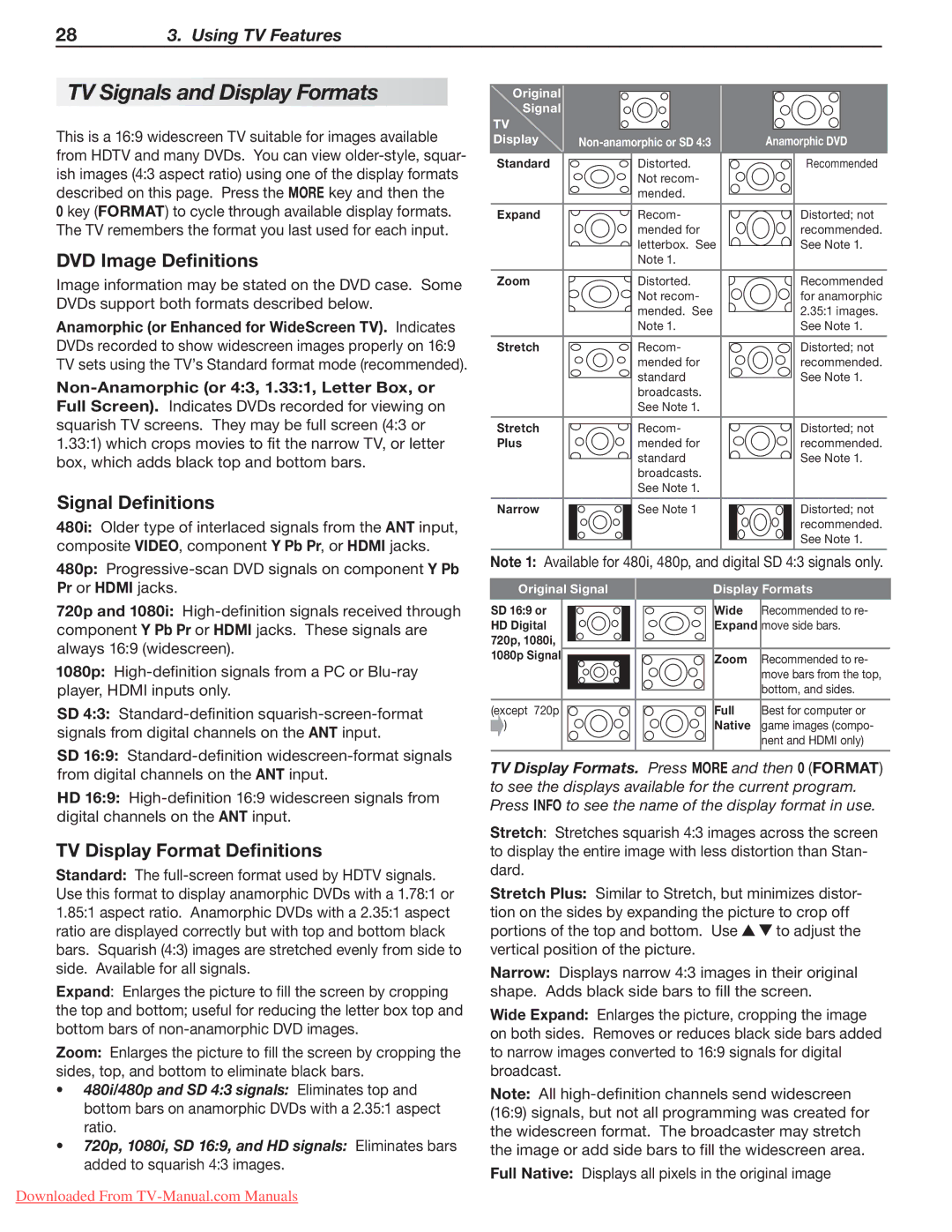
283. Using TV Features
TV Signals and Display Formats
This is a 16:9 widescreen TV suitable for images available from HDTV and many DVDs. You can view
0key (FORMAT) to cycle through available display formats. The TV remembers the format you last used for each input.
DVD Image Definitions
Image information may be stated on the DVD case. Some DVDs support both formats described below.
Anamorphic (or Enhanced for WideScreen TV). Indicates DVDs recorded to show widescreen images properly on 16:9 TV sets using the TV’s Standard format mode (recommended).
Signal Definitions
480i: Older type of interlaced signals from the ANT input, composite VIDEO, component Y Pb Pr, or HDMI jacks.
480p:
720p and 1080i:
1080p:
SD 4:3:
SD 16:9:
HD 16:9:
TV Display Format Definitions
Standard: The
Expand: Enlarges the picture to fill the screen by cropping the top and bottom; useful for reducing the letter box top and bottom bars of
Zoom: Enlarges the picture to fill the screen by cropping the sides, top, and bottom to eliminate black bars.
•480i/480p and SD 4:3 signals: Eliminates top and bottom bars on anamorphic DVDs with a 2.35:1 aspect ratio.
•720p, 1080i, SD 16:9, and HD signals: Eliminates bars added to squarish 4:3 images.
Downloaded From
Original
Signal
TV |
|
|
Display |
| Anamorphic DVD |
Standard | Distorted. | Recommended |
| Not recom- |
|
| mended. |
|
Expand | Recom- | Distorted; not |
| mended for | recommended. |
| letterbox. See | See Note 1. |
| Note 1. |
|
Zoom | Distorted. | Recommended |
| Not recom- | for anamorphic |
| mended. See | 2.35:1 images. |
| Note 1. | See Note 1. |
Stretch | Recom- | Distorted; not |
| mended for | recommended. |
| standard | See Note 1. |
| broadcasts. |
|
| See Note 1. |
|
Stretch | Recom- | Distorted; not |
Plus | mended for | recommended. |
| standard | See Note 1. |
| broadcasts. |
|
| See Note 1. |
|
Narrow | See Note 1 | Distorted; not |
|
| recommended. |
|
| See Note 1. |
Note 1: Available for 480i, 480p, and digital SD 4:3 signals only.
Original Signal | Display Formats | |
SD 16:9 or | Wide | Recommended to re- |
HD Digital | Expand move side bars. | |
720p, 1080i, |
|
|
1080p Signal | Zoom | Recommended to re- |
| ||
|
| move bars from the top, |
|
| bottom, and sides. |
(except 720p | Full | Best for computer or |
) | Native | game images (compo- |
|
| nent and HDMI only) |
TV Display Formats. Press MORE and then 0 (FORMAT) to see the displays available for the current program. Press INFO to see the name of the display format in use.
Stretch: Stretches squarish 4:3 images across the screen to display the entire image with less distortion than Stan- dard.
Stretch Plus: Similar to Stretch, but minimizes distor- tion on the sides by expanding the picture to crop off
portions of the top and bottom. Use to adjust the vertical position of the picture.
Narrow: Displays narrow 4:3 images in their original shape. Adds black side bars to fill the screen.
Wide Expand: Enlarges the picture, cropping the image on both sides. Removes or reduces black side bars added to narrow images converted to 16:9 signals for digital broadcast.
Note: All
Full Native: Displays all pixels in the original image
